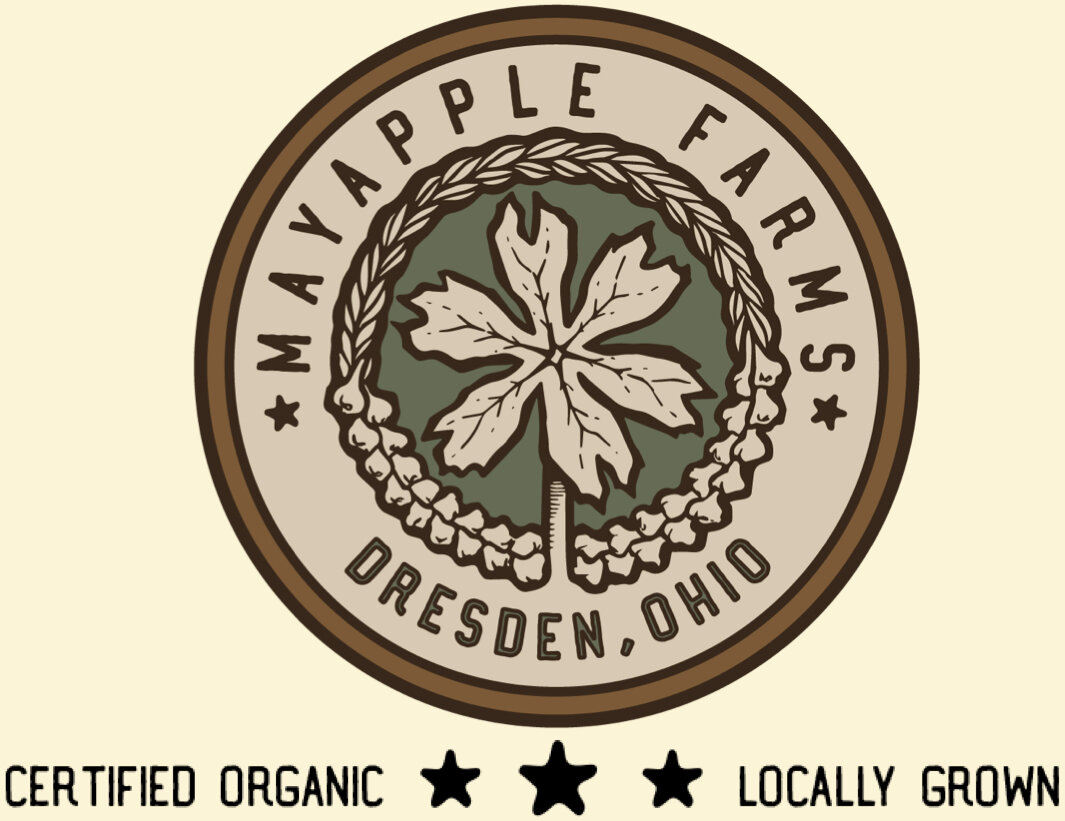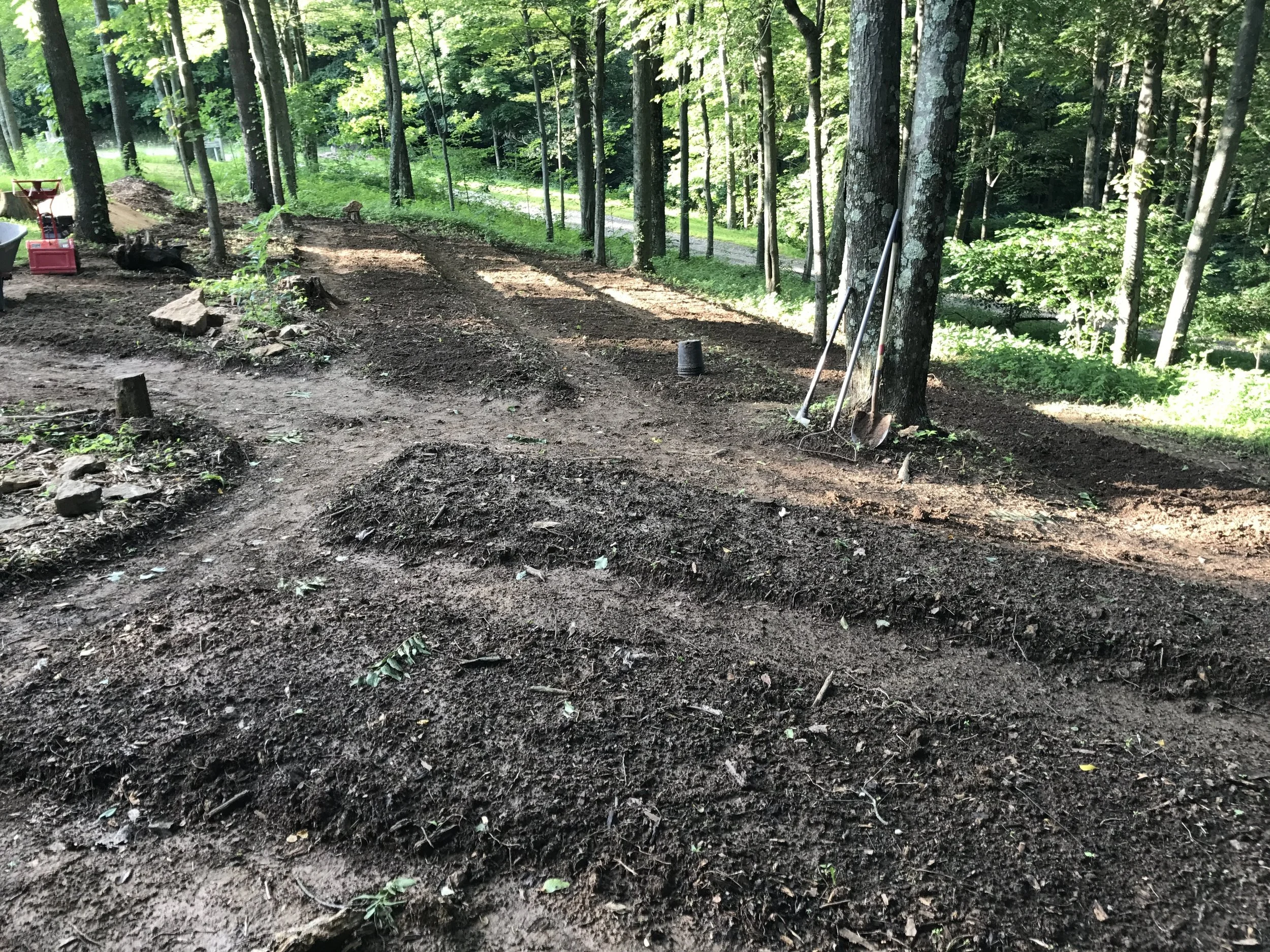Welcome to Mayapple Farms
Introductions
We’re the Felumlees - Rick, Jan, Elijah and Emma - and we own and operate Mayapple Farms – a small, diversified forest farm near Dresden, Ohio where we live, work and play. This has been a dream of ours for a long time, and we’ve been planning and working for years to get ready to take that next step. Then about two months ago, ready or not, we took that next step. I left my cushy desk job with a major insurance company to work full-time building and growing our farm. Jan is making a huge sacrifice staying at that same insurance company, for now anyway, so we can maintain a steady income and insurance. Our goal is for Jan to transition to working on our farm full-time as soon as possible, but we have a lot of work to do in the meantime.
Even though we’re still building and growing - and we won’t have anything ready for sale until later this fall - we thought it might be worthwhile to share our progress as we go along. We’ll be posting regularly about our projects, plants and random happenings around the farm. Upcoming posts include a peek inside our new plant nursery area currently under construction, videos on growing mushrooms, propagating elderberry from cuttings, and planting bloodroot seeds with Elijah.
This post is an introduction to our family and farm. Hope you enjoy.
A Word about Our Farm
Our farm sits in northwestern Muskingum County – on the far western edge of Appalachia – where the rolling hills start to level out and transition to the plains that were scoured flat by the last glaciers. The land here looks like it got wrinkled up into rows of rolling foothills with narrow valleys between carved out by all sizes of creeks and streams, then more hills, and more valleys, and on and on eastward basically all the way to Virginia. The hills here are covered with large tracts of hardwood forests of Sugar Maple, Red Oak, Beech, Wild Cherry interspersed with open farm land in the valleys and low hills. The woods are teeming with wildlife. It's not uncommon to see White-Tail Deer or Wild Turkey roaming our yard. At night, you can hear Barred Owls and Coyotes calling. Occasionally, you might even glimpse a Mink, Red Fox or Pileated Woodpecker. In addition to the animals, the forest floor is carpeted with hundreds of species of native plants that have been growing here for millennia.
Our lot is narrow, just 200 feet wide, but it runs up and over a hill for about a quarter of a mile, just past a small creek in the back. The lot is just over six acres total and it’s mostly wooded with mature Sugar Maple, Black Walnut, Cherry, Beech and Oak trees. Sadly, most of our Ash trees are dead or dying due to the Emerald Ash Borer. We think the east side of the hill was probably pasture at some point 40-50 years ago because the understory on that side of the hill is thick, with lots of Multi-flora Rose, and many of the trees are similar in size. The west side of the hill is different – covered with very large old trees that create a very tall and thick canopy with very little understory growth. Plants like bloodroot, black cohosh, ramps and elderberry grow wild on this side of the hill.
Our Story
I mention all this detail because it was largely the land itself – the hill, the woods, the shade – that ultimately led us to forest farming. Jan and I were high-school sweethearts and got married in 1999. At the time, we lived in an old duplex apartment in Lancaster where I was working at the time, but wanted to move back to Muskingum County to be closer to family and friends. Shortly after the wedding we bought this land from an old friend, and started the long process of clearing land for the driveway and house site, and installing utilities. Our house design went through numerous revisions, each one ending in a simpler and smaller plan than the last. We eventually settled on an open design plan for a 1500 square foot home. We owned a small portable sawmill at the time and initially intended to build a complete timber-framed house. After realizing exactly how much time and effort that was going to require, we adjusted course and went with a hybrid design where the exterior walls are traditional insulated 2x6 walls, but the interior is open and supported with large 8x8 posts and beams that we milled from local Poplar logs and fitted together ourselves. The house also incorporates several passive solar design elements to take maximum advantage of the sun's free light and heat. For example, we aligned the house with a compass so the long side faces due south. We loaded up the south facing walls and roof with lots of windows and skylights to let the sun shine in. We also designed the house with extra-wide eaves that block the high summer sun but let the low winter sun come streaming in to naturally warm up the finished concrete floors that act like thermal batteries - staying warm long after the sun goes down. All these elements do help, but it gets cold here in Ohio and we primarily heat the house with a hot-water radiant heat system in our floors, powered by an outdoor wood burner that also heats our household water. We use dead wood and storm fall from around the farm for firewood each year and stay nice and cozy.
I think we finally moved into the house sometime in 2003. Our son Elijah was born in 2006, followed by our daughter Emma in 2012. During that time I worked in a factory that made plastic car parts, as a carpenter for a commercial construction company, with a buddy selling antiques and collectibles on ebay while I went back to school to finish my degree, for a large bank hawking credit cards and checking accounts (especially hated that job), and then most recently as a claims adjuster for the large insurance company mentioned above. In most cases, it began with excitement that soon faded into boredom, that later mutated into various forms of anxiety and self-doubt. At some point, maybe a couple years ago, I realized I needed to figure out a way to become self-employed doing something that I could really feel good about.
“The cost of a thing is the amount of what I will call life which is required to be exchanged for it, immediately or in the long run.”
So about four years ago we started brainstorming ways to make a little income by growing things on our property. We've always had a small garden for ourselves, and I've enjoyed gardening going back to digging potatoes in my mom's garden as a kid. Since we're fortunate enough to have a large healthy woodlot, we focused our research on plants that would grow in the shade, and before long serendipity intervened and we discovered American Ginseng, and then the other forest herbs like Black Cohosh, Goldenseal and Bloodroot, many of which are in decline due to generations of irresponsible harvesting from the wild. We we’re drawn not only to the high market prices of these plants, and the fact they are native to this area, but also to the idea of ‘conservation through cultivation’ – that by actively cultivating these plants, and harvesting them in a sustainable way, we could alleviate some of the over-harvesting pressure on wild plant populations. We loved the idea of 'doing well by doing good,' and our plan began to take shape.
We started planting Ginseng seriously in 2014. The following year we discovered that a large part of our western hillside is covered with Ramps in the spring. We just never knew what we were looking at until I bought a book about Ginseng and it happened to have a chapter on Ramps with lots of good photos. Boy was excited when I realized what we had. Later, as we learned more about other woodland medicinal plants, we also found wild patches of Bloodroot, Black Cohosh and Jack-In-The-Pulpit. Everytime I found something new, I would run up to the house, photos in hand, to show Jan and the kids.
The first bundle of ramps we ever dug up.
We knew we needed to diversify our offerings so we tweaked our plan to incorporate nursery plants, mushroooms, garlic and elderberries. Then earlier this year, after a lot of careful consideration, we decided to move forward. I would quit my job and spend the rest of the year building and planting, getting everything ready to take to market next season. I agonized over this for what seemed like an eternity. I'm not a big risk-taker by nature. But when I finally handed over my two-week notice to my boss, I really felt at peace with the decision.
Looking Forward
That was a couple months ago. Since then, we've been incredibly busy as we set a pretty aggressive schedule for our projects. Currently, we are building our plant nursery - a protected area where we can propagate and raise young plants until they are big enough to plant out, or sell as potted plants. We're also building a number of special beds to grow mushrooms in the woods, including Red Wine Cap, Wood Blewit and Almond Agaricus. We're building new raised beds to expand our garlic planting this fall. Currently we grow four varieties of hard-neck garlic: Russian Red, Spanish Roja, Iowa German White and Chesnok Red. We're deciding now whether to add more varieties now or later - we'll see. Later this summer we will be constructing our herb dryer, planting lots of ginseng seeds, and propagating/planting our nursery. In the meantime, we make time to care for our garden, fruit trees, children (not necessarily in that order).
Next year, we plan to start growing Shiitake, Reishi and Oyster mushrooms naturally on logs, expand our garlic beds again, and continue our experimentation with making our own maple syrup. Finally, we hope that our fruit trees and berry bushes will start producing enough next season to sell small amounts as seasonal treats. Longer term, we're going to offer tours and workshops at the farm so folks can get hands-on with these amazing plants, and learn about their true value. Education is part of our mission and we see it as another opportunity to do well by doing good.
We’re constantly learning, growing and building the farm. In upcoming posts, we’ll dive a little deeper into forest farming, permaculture and the organic growing techniques we use. We’ll also update you on our current projects and let you know when we expect each of our products to be available. Please bookmark us, follow us on social media (links above), and share with your friends and family.
We really appreciate your interest and we’ll be in touch soon.
The Felumlees
Mayapple Farms







Winter is a pretty exciting time around our farm, believe it or not. We’ve been busy planning all the details of the coming season, picking out seeds (my personal favorite), and updating stuff like our logo and website.